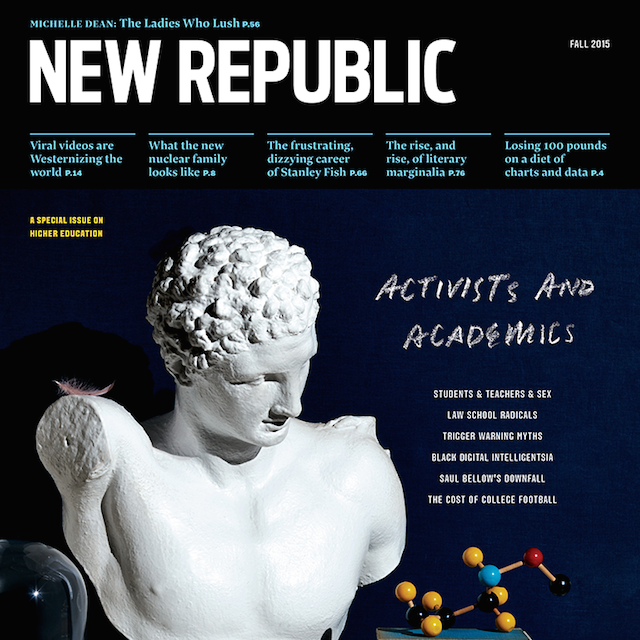The New Republic is for sale. Its owner, Facebook co-founder Chris Hughes, announced in a post on Medium Monday that the venerable political publication “needs a new vision that only a new owner can bring.” Hughes purchased the New Republic in 2012 and made numerous stabs at making it influential and profitable, impulses that haven’t always coexisted smoothly.
One of Hughes’s early acts as owner was to hire Franklin Foer as editor, then assemble a staff that shared Foer’s desire to protect the magazine’s legacy while it navigated the transformation of the journalism business to mostly digital readership. And in late 2014, he fired Foer, part of an attempt to transform the organization into what CEO Guy Vidra called a “vertically integrated digital media company.”
So what’s one of those go for these days? Hughes reportedly bought the publication for $2.1 million. In his letter, Hughes says TNR’s “search for a workable business model has come up short,” despite a never-ending stream of ideas like New Republic-branded bookstores and cafes and a newish in-house content-marketing studio called Novel, which I am informed would convey with TNR’s print magazine and digital properties.
The New Republic was in bad shape when Hughes bought it. Former owner Martin Peretz sold most of the magazine to to the Canadian media group Canwest Global Communications Corp in 2007. (“We just didn’t have the $3 million a year to spend any more,” Anne Peretz told the New York Times). He bought most of it back two years later. But by 2011 its print circulation had dropped below 30,000, and its financial outlook was very grim.
Richard Just, the editor in 2011, contacted Hughes through a mutual acquaintance and asked whether he’d be interested in investing in the publication. Hughes bought a majority stake and, not much later, fired Just and brought back Foer. He promised to “expand the amount of rigorous reporting and solid analysis.” He reportedly told people he hoped to turn the publication into a “New Yorker of D.C.”
In his letter, Hughes says he’s put more than $20 million into the New Republic. A potential new owner would be fairly interested in knowing where that went, besides, of course, very nice office spaces in DC and New York (you can see Hughes’ NYC office in the photo atop this story).
I’m not privy to the New Republic‘s profit-and-loss statements, but let’s assume from his statements that Hughes isn’t getting rid of the publication because it’s throwing off vast amounts of money, or even breaking even. According to TNR’s most recent statement filed with the Alliance for Audited Media, it has print circulation of 41,607 (which includes about 9,500 subscribers to TNR’s digital edition). Its media kit claims 2.7 million monthly unique visitors to its website, though numbers I got from the metrics firm comScore–which look a bit low to people who have seen TNR’s internal metrics over the past few years–say it had an average of 1.6 million unique visitors from November 2014-November 2015.
That’s not a huge user base. The pitch to a potential new owner is the quality instead of the size of the New Republic‘s audience. The media kit touts the long amount of time it says readers spent on “top-performing content” last year (8.5 minutes) and the large number of pageviews returning readers hit on average (5.1).
Any decision to sell the publication based on loyalty, though, is complicated by its recent history. Much of the masthead followed Foer out of the door, and the publication has pursued (wisely, in my opinion) new readers in its reboot under Editor-in-Chief Gabriel Snyder. Snyder has aggressively pursued more diversity among TNR’s once-homogenous staff, who used to discuss whether potential applicants were smart or “TNR smart” (the people who passed that test apparently just happened to be very similar).
But what does that new brand mean to readers? As the media-business analyst Rick Edmonds notes in a good piece about TNR’s potential sale, there are plenty of lefty outlets that offer young writers an “editorial mix of commentary, in-depth reported pieces and literary essays”–with bigger platforms, and without any of the attendant drama and periodic identity crises. TNR shed its old brand publicly, but its replacement is still very much a work in progress.
Reached by email, Edmonds (a former coworker of mine) says he believes that any sales price for the New Republic would be “very low,” citing the sales of Businessweek (for reportedly $5 million in 2009) and Newsweek (which sold for $1 in 2010 and for an undisclosed amount in 2013).
“The bigger expense for a buyer will be covering ongoing losses and investing in transformation initiatives,” Edmonds says.
Raju Narisetti, who helped bring the social news agency Storyful to News Corp, says Hughes’ letter has “interesting parallels” to the 2013 sale of the Washington Post to Amazon founder Jeff Bezos, where previous owners “also said that their efforts to develop a sustainable business model have failed and that it was time for the Post to have a new vision, resources and ownership.” Ever since, Bezos’ personal fortune has given the Post the financial runway it needed to pursue digital success as its print business declined.
With luck, Narisetti says, “TNR might end up in the hands of someone who isn’t buying it for short-to-medium term profits and has the resources and patience to give it a shot, minus the drama the previous owners created.”
Indeed, Hughes suggests that TNR’s possible futures could include being “run as part of a larger digital media company, as a center-left institute of ideas, or by another passionate individual willing to invest in its future.”
Wait a second, isn’t that last one the business model the New Republic already has? In other words, a billionaire owner. Just not this one.



















